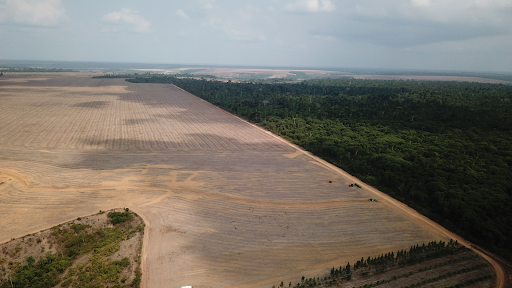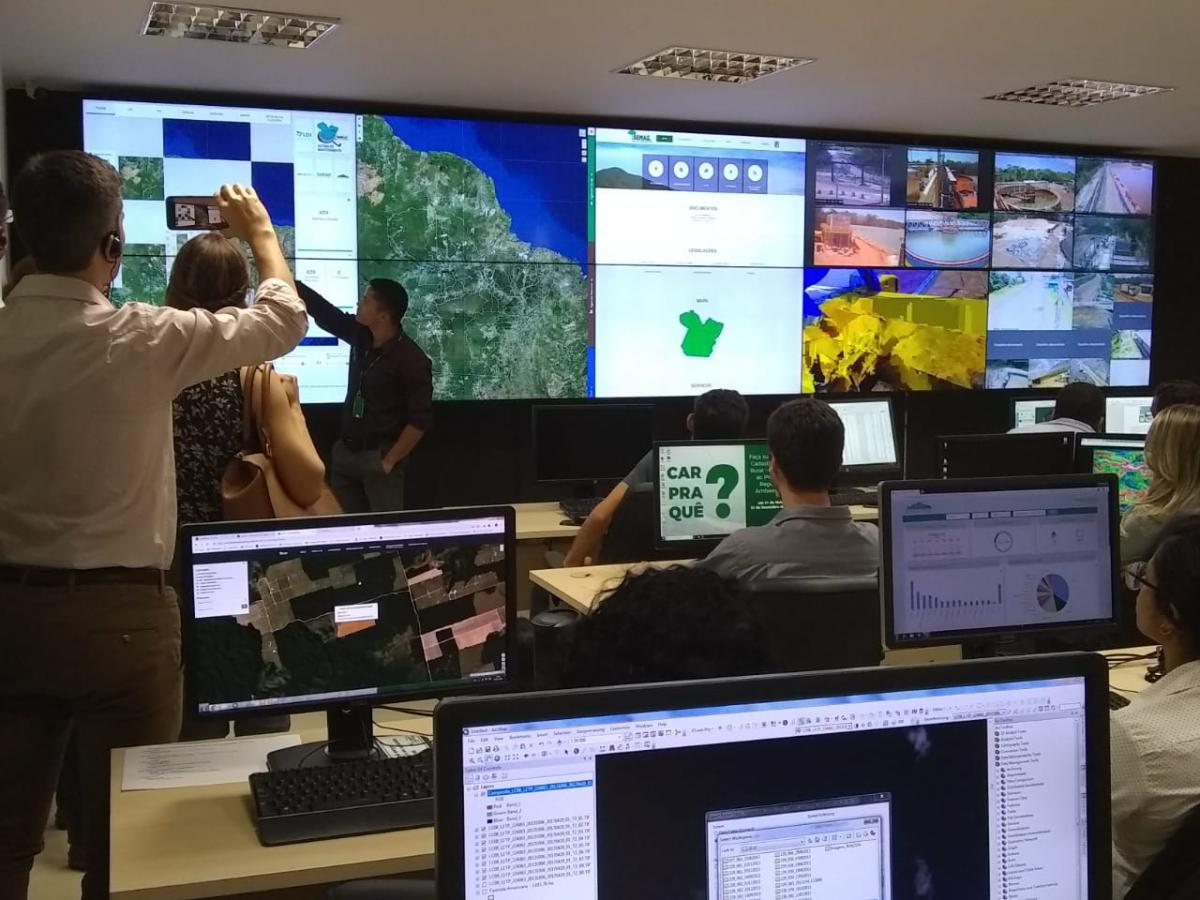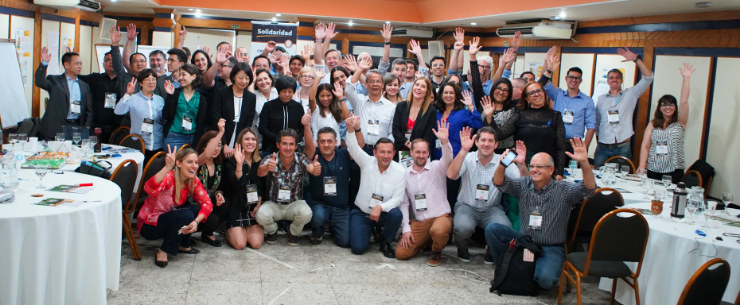
Example of aerial land use monitoring
The soy value chain is comprised of a vast network of millions of producers, service providers, processors, traders and end-users who are dispersed over the world with low levels of connectivity or engagement between them. The network is also distributed over immense territories with a high level of ecosystemic, economic, legal and social diversity and the different markets where the commodity is produced, traded and transformed, result in highly distinct value chain configurations.
Soy’s significance
The size of this network is also a consequence of the importance of soy as an agricultural commodity in the world, occupying an important position in terms of the amount of agricultural land available destined to produce this crop (16%), with a relative preponderance of more than 35% when only considering the surface area regarding oilseeds. The valuation of the primary production (field production) considering the average harvested annual volume (350 (M) metric tonnes (MTn)) ascends to more than US$ 116.2 billion. Additionally, when the processing and derivative markets are taken into account, at least US$ 182 billion of added value should be included.
Overall, the commercialization of soybeans and their by-products accounts for more than 10% of the total value of global agricultural trade. The size of the value chain has several related issues and negative impacts that are difficult to overlook, such as impacts on Land Use Change (LUC) and deforestation, an aspect especially sensitive since it is linked to climate change and biodiversity loss.
Domestic diversity
Yet, despite the importance of soy in the global agricultural trade and of the importance of the impacts the value chain has, concrete efforts and results to mitigate negative effects have been scarce. One of the main reasons behind this is the difficulty to globally align with the high number of stakeholders involved and to deal with the environmental, economic, social and legal diversity in the different regions where it is produced, processed and traded. This is why farm level efforts have had little impact on the value chain, not only because of the difficulty in creating critical mass, but because the diversity of stakeholders and economic processes have not been taken into account. However, this challenge might also be interpreted as an opportunity to work on developing and designing solutions that are able to work with and address this heterogeneity.
Solidaridad organizes second study tour for South America-China soy relations (with English subtitles)
In South America, for example, one of the vulnerable links for ensuring responsible soy production lies in the effectiveness of regional spatial or territorial planning policies, and in the robustness and quality of forest management systems, including information on deforestation monitoring and control.
Solidaridad has identified that major soy producing countries in South America approach monitoring deforestation processes and management differently. They use different types of sensors, criteria, procedures and compliance requirements. Such divergence compromises the reliability of data generation as differences created in terms of indicator measurement, information availability and frequency of publishing as well as differences in precision, create differences in the capacity of each system to determine changes in land use. These differences hinder the capacity of organizations to act based on that information.
Technology troubles
Technological limitations are also an important influencing factor, where for example, some countries have limited storage capacity for satellite imagery, making it difficult to keep historical data. In addition, there are differences between the satellites used in terms of their precision: some can capture changes within a three-square-meter range, while others do so within a 10-hectare range.
In this regard, adoption of high quality monitoring systems is paramount for early detection in land use changes. The relationship between accuracy and frequency of data generation in monitoring systems is essential to ensure early detection of events linked to changes at land use level, especially illegal deforestation. The time difference between the occurrence of a land use change event and its detection is one of the keys to either avoiding illegal deforestation or allowing for its full impact. In order to picture it more clearly, a land-owner, realty speculator or a producer, for example, could be planning to illegally clear an area of 500 Ha at a rate of 50 Ha per day; if deforestation is detected on the first day, an area of 450 Ha can be conserved.

The satellite system used in Pará allows for close-up imaging down to 3 square meters, identifying native forests and even tree species.
Several other restrictions in technology affect the capacity to precisely manage land clearing. Images with a high level of resolution are needed to perform precise picture overlapping to create a continuous area map. Because of human error, inaccuracies can be generated when identifying and circumscribing land clearing areas, resulting in over or underestimations. This can lead to not detecting the whole area affected, especially when a producer clears beyond what is allowed, or, on the contrary, a producer can be negatively affected through legal prosecution or economic sanctions for clearing an area claimed to be larger than what a producer actually may have legally cleared.
Good governance
In terms of legal frameworks, an important aspect that needs to be considered is the fact that control systems usually work with a restrictive or sanctionatory perspective, limiting the area of production with little to no economic incentives and dismissing any of the opportunity costs landowners have. It is logical to think, at least from a producer's point of view, that there is a need to put in place a mechanism that pays for conserving forests, whether in the form of premiums or payments for environmental services.
Examples exist, like the case of farmers in what is known as the “anthropogenic Amazon”, who are held legally responsible not only for not clearing out land but for investing efforts in protecting non-productive areas that can cover up to 50% of a property. There is still no clear business model that can finance a significant relative amount (e.g. 80%) of the opportunity cost of conserving forests within farms, so that legal compliance is economically viable for the producer, an issue which deserves discussion.
Multi-level measures
So far, the private sector has led the development of systems that guarantee responsible soy supply at a supply chain level with static compliance check models, which fall short of encompassing the complexity of a dynamic and adaptive business environment. At public level, on the other hand, the challenge is that there is a multiplicity of systems that are difficult to articulate and harmonize. There are also successful interventions which occur on a local scale yet do not have enough impact on a value chain level.
Although, pioneer municipalities such as Pará in Brazil, have reached almost 2 million tons of soy under environmental legal compliance, this does not represent even 1% of world trade.
Thus, it is of utmost importance that we learn from successful initiatives and start developing them in other countries.
Standardizing soy
In this article, only a few constraints have been described based on Solidaridad´s experience in current projects regarding the need for robust and regionally integrated monitoring systems to reduce illegal deforestation. However, other components which are equally significant are in need of bolstering to eventually eradicate illegal deforestation, elements that include at least governance models, specific administrative public procedures and requirements, multi-component digital spatial information and territorial planning technologies, to mention but a few.
To advance regional integration and capacity building processes, Solidaridad is advocating among relevant public, private and civil society organizations for the creation of a platform to exchange information between soy producing countries in South America and China. One that allows for comparing and analysing data in terms of monitoring systems’ transparency, traceability, tools and governance, and to enable knowledge and experience exchanges and technology transfer between countries.

Join us!
Solidaridad has also taken significant steps in building capacity at national or provincial levels through multi-stakeholder dialogue-based platforms designed to increase capacity in the effectiveness of land use change monitoring and control systems. To continue this process, Solidaridad needs support from the international community.
We invite and encourage willing organizations to join our current efforts in strengthening bottom-up territorial governance mechanisms and initiatives that empower local communities and up-value democracy. Get in touch and join us in change that matters!
This blog was originally published on LinkedIn. Follow Alex Ehrenhaus to stay up to date on developments in the international soy supply chain.
Learn more about responsible soy production.
Further reading:
